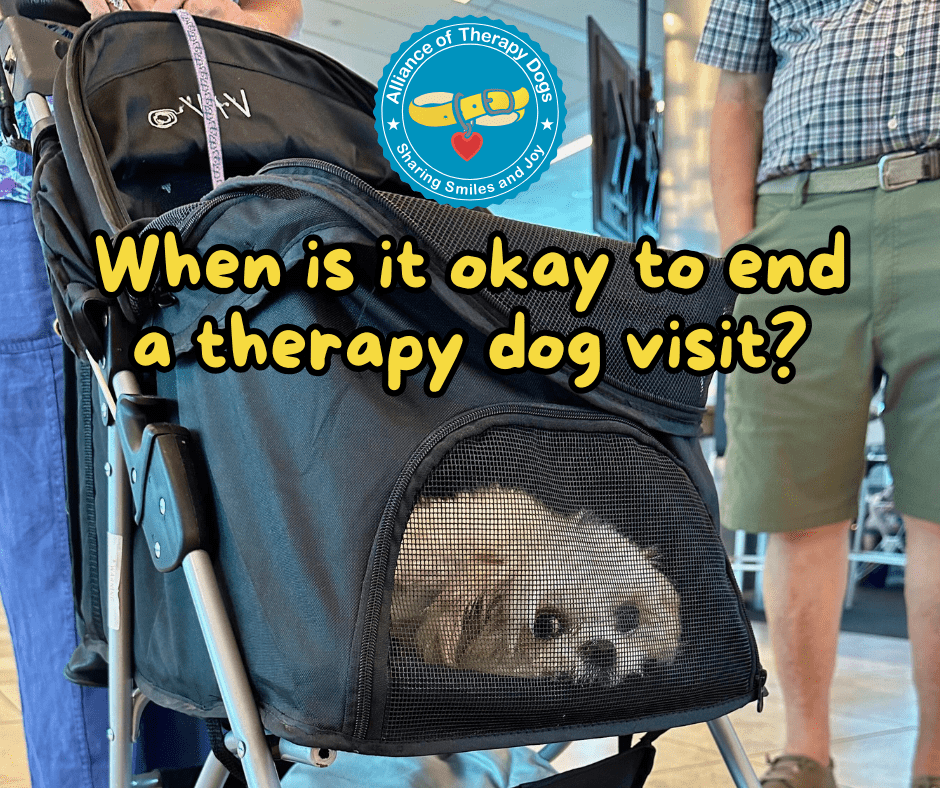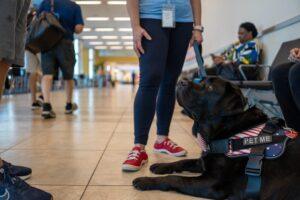A question that is often asked by Members new to therapy dog work is when is it OK to end a therapy dog visit early? The short answer is always. As volunteers, we feel obligated to fulfill our duties to those we are visiting, but the most important thing to remember on a therapy dog visit is that our dogs always come first. Our dogs do not have the ability to let us know how they are feeling through words, so it is important that we listen to what they are telling us through their body language. Our dogs should have a choice to go on a visit or not. If your dog does not feel like visiting that day, it’s important that we respect that. By listening to our dogs and ending visits early, this sets our dogs up for success on their next visit. Your facilities should also respect your dog and understand that if your dog is not comfortable, the visit should not continue.
Chances are, most seasoned therapy dog handlers have had to end a therapy dog visit early for one reason or another. Once you’ve had to end a therapy dog visit early, it’s easier to do the next time. Here are three examples of when our Board President and a few of our Directors have had to end a visit early:
Don Vaughan, ATD President, wrote:
A number of years ago, my wife and I were at one of our regular visits at a juvenile detention center. A young autistic boy enthusiastically greeted Gaag (Gawg like dawg), our St. Bernard, throwing his arms around our dog with affection. Gaag was happy to say hello. Then moments later, the boy quickly ended the engagement by pushing our St. Bernard away.
Gaag seemed a little surprised by the abrupt change but went on to visit with the other juveniles. About 20 minutes later, the boy’s enthusiasm over our St. Bernard returned with another embrace, only to end again shortly afterward when the boy’s enthusiasm ended again pushing Gaag away.
Clearly the boy was sending mixed messages, which was stressful for our dog. Gaag had not experienced this before, and you could tell that he wasn’t sure how to take it. After being pushed away the second time and seeing that Gaag was stressed by the events, one of us was able to remove Gaag from the situation since we were both certified handlers. We decided to cut the visit short. But before we left, the other one of us was able to talk with the juveniles at the visit, explaining why we had to cut the visit short.
Though it wasn’t the way we planned for our visit to go, we kept a focus on everyone’s safety and well-being and used the situation as a teaching opportunity for the kids we were visiting.
Kim Williams, Director (Immediate Past President), wrote:
My corgi, Penny, was the kind of dog I could take to various facilities and situations. She was rock solid. However, every time we visited the local halfway house, if one gentleman in particular was present, she would turn and look at the door, signaling that the visit was over. I never understood what it was about that gentleman. We could stay an hour if he didn’t show up, leave as soon as he arrived, or wait until he came into the room and then make our exit. Fortunately, other teams were on the same visit and would stay for the entire scheduled time. It didn’t take long for me to realize her behavior was tied to one person. I decided not to continue going to the halfway house to avoid hurting feelings in case her behavior was noticed.
Jessica Davis, Director, wrote:
The best time to end a therapy dog visit is when my dog shows signs of tiredness, such as slowing down, yawning, excessive panting, or avoiding interaction. My therapy dog, Diego, typically begins to wind down after about an hour, at which point he needs a mental and physical break. We generally go outside for a potty break, quick sniffy walk and to get some water. If at any point he becomes “passive-aggressive” and walks past people or stops to stare off into the distance like an existential crisis, that’s my cue. At the first sign of any restlessness or jumpiness, I politely excuse myself and let everyone know it’s time to wrap up. I smile and quickly guide him out and take him for a pup cup.
Even the best therapy dogs have off days or people they are wary of. By listening to our dogs and respecting their feelings, it helps our dogs continue enjoying the job they do. Has your dog ever displayed behaviors letting you know they were no longer enjoying the visit? Did you end your visit early? Leave a comment telling us about your experience so others can learn from you as well!





